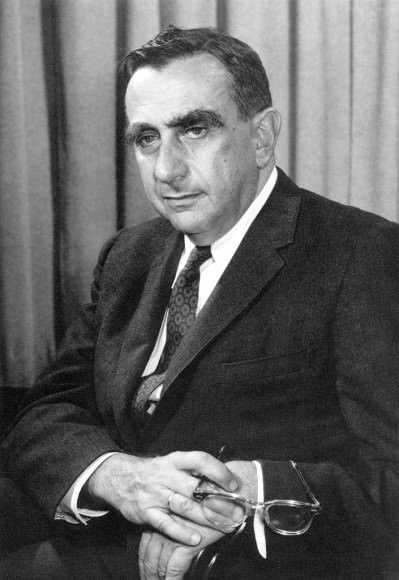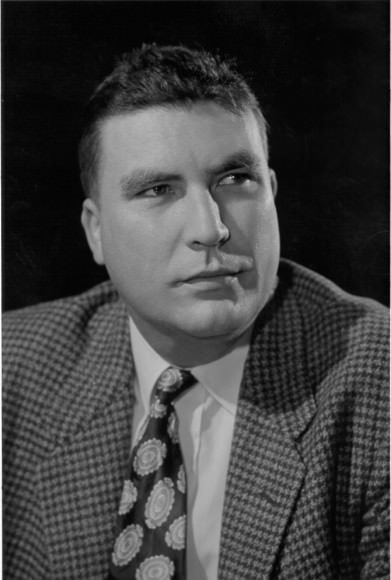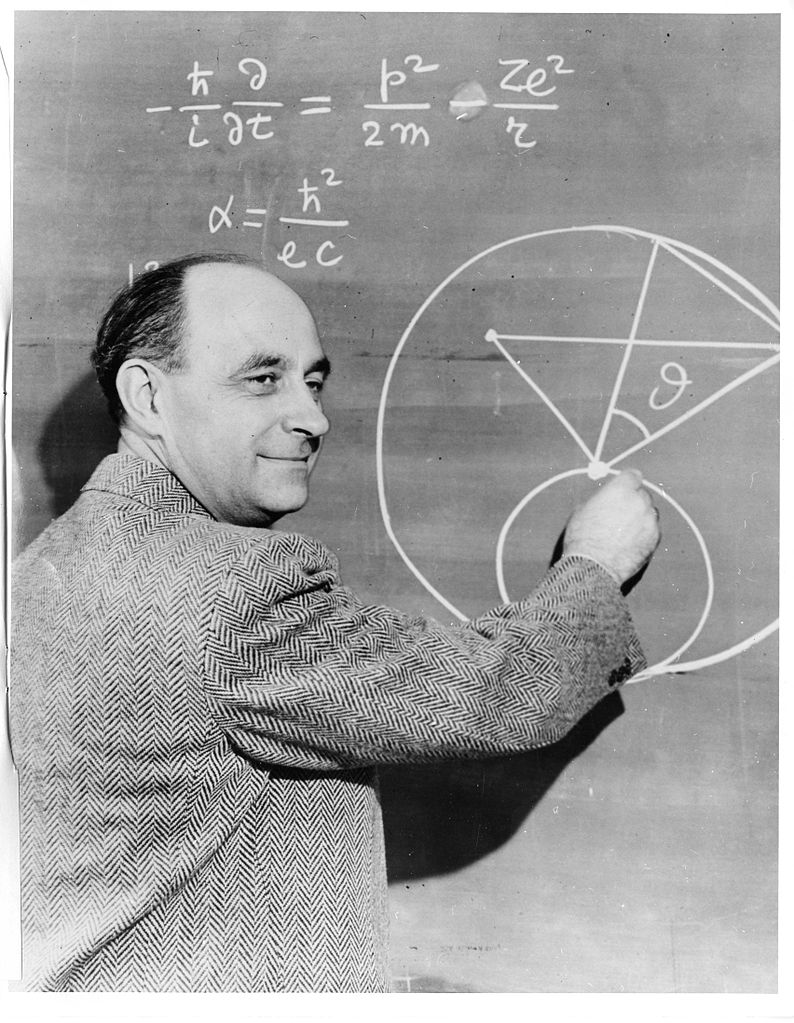Welcome back to our Fermi Paradox series, where we take a look at possible resolutions to Enrico Fermi’s famous question, “Where Is Everybody?” Today, we examine the lunchtime conversation that started it all!
It’s become a kind of legend, like Newton and the apple or George Washington and the cherry tree. One day in 1950, the great physicist Enrico Fermi sat down to lunch with colleagues at the Fuller Lodge at Los Alamos National Laboratory in New Mexico and came up with a powerful argument about the existence of extraterrestrial intelligence, the so-called “Fermi paradox”.
But like many legends, it’s only partly true. Robert Gray explained the real history in a recent paper in the journal Astrobiology. Enrico Fermi was the winner of the 1938 Nobel Prize for physics, led the team that developed the world’s first nuclear reactor at the University of Chicago, and was a key contributor to the Manhattan Project that developed the atomic bomb during World War II. The Los Alamos Lab where he worked was founded as the headquarters of that project.
The line of reasoning often attributed to Fermi, in his lunchtime conversation, runs like this: There may be many habitable Earth-like planets in our Milky Way galaxy. If intelligent life and technological civilization arise on any one of them, that civilization will eventually invent a means of interstellar travel. It will colonize nearby stellar systems. These colonies will send out their own colonizing expeditions, and the process will continue inevitably until every habitable planet in the galaxy has been reached.
The fact that there aren’t already aliens here on Earth was therefore supposed to be strong evidence that they don’t exist anywhere in the galaxy. This argument actually isn’t Fermi’s and was published more than 25 years later by astronomer Michael Hart. It was elaborated in a paper published by the cosmologist Frank Tipler in 1980.
Fermi’s lunch conversation really did happen. Although he died just four years later of cancer, physicist Eric Jones published the recollections of the physicist’s luncheon companions more than thirty five years later. Among these companions were Edward Teller, Emil Konopinski, and Herbert York, all eminent physicists and veterans of the Manhattan Project. Teller played a central role in the development of the hydrogen bomb. Konopinski studied the structure of the atomic nucleus, and York became director of Lawrence Livermore National Laboratory.

During the walk to the Fuller Lodge, the physicists discussed a recent spate of UFO sightings, and a cartoon in the New Yorker Magazine depicting aliens and a flying saucer. Although the topic of conversation moved on as the group sat down for lunch, Edward Teller recalls “in the middle of the conversation, Fermi came out with the quite unexpected question ‘Where is everybody?’…The result of his question was general laughter because of the strange fact that in spite of Fermi’s question coming out of the clear blue, everybody around the table seemed to understand at once that he was talking about extraterrestrial life”.
In his account of the famed luncheon, Teller wrote “I do not believe much came from this conversation, except perhaps a statement that the distances to the next location of living beings may be very great and that, indeed, as far as our galaxy is concerned, we are living somewhere in the sticks, far removed from the metropolitan area of the galactic center”.
York recalled a somewhat more expansive discussion in which Fermi “followed up with a series of calculations on the probability of earthlike planets, the probability of life given an earth, the probability of humans given life, the likely rise and duration of high technology, and so on. He concluded on the basis of these calculations that we ought to have been visited long ago and many times over”.
According to York, Fermi supposed the reason we hadn’t been visited “might be the interstellar flight is impossible, or if it is possible, always judged not worth the effort, or technological civilization doesn’t last long enough for it to happen”.
So Fermi, unlike Hart, wasn’t skeptical about the existence of extraterrestrials, and didn’t view their absence from Earth as paradoxical. There is no Fermi paradox, there is simply Fermi’s question “Where is everybody?”, to which there are many possible answers. The answer that Fermi preferred seems to be that, either interstellar travel isn’t feasible because of the enormous distances involved, or Earth simply had never been reached by alien travelers.

Interstellar distances are truly vast. If the entire solar system out to the orbit of Neptune were reduced to the size of an American quarter, the nearest star, Proxima Centauri, would still be about the length of a football field away. A practical starship would either need to travel very fast, at an appreciable fraction of the speed of light, or be capable of supporting its crew for a very long time. While either is theoretically possible, interstellar travel seems to present day humanity to be such a grandiose undertaking that it’s not clear whether any civilization would be able or willing to muster the enormous resources needed.
Where did the confusing of Fermi’s question with Hart’s argument come from? Carl Sagan mentioned Fermi’s question in a footnote to a 1963 paper. After the publication of Hart’s paper in 1975, Fermi’s question and Hart’s speculative answer became associated in many writer’s minds. Fermi’s question seemed to beg Hart’s answer, and “Fermi’s paradox” was born. According to Robert Gray, the term was coined by D. G. Stephenson, in a paper published two years after Hart’s.
Why is it important that Hart’s argument was never really made by the eminent physicist Enrico Fermi? Did Michael Hart and Frank Tipler really make a compelling case that extraterrestrial civilizations don’t exist in our galaxy? We’ll answer those questions in the second installment.
We have written many interesting articles about the Great Filter, the Fermi Paradox, the Search for Extraterrestrial Intelligence (SETI), and related concepts here at Universe Today.
Here’s Where Are The Aliens? How The ‘Great Filter’ Could Affect Tech Advances In Space, Why Finding Alien Life Would Be Bad. The Great Filter, How Could We Find Aliens? The Search for Extraterrestrial Intelligence (SETI), and Fraser and John Michael Godier Debate the Fermi Paradox.
And be sure to check out the rest of our Beyond Fermi’s Paradox series:
- Beyond “Fermi’s Paradox” II: Questioning the Hart-Tipler Conjecture
- Beyond “Fermi’s Paradox” III: What is the Great Filter?
- Beyond “Fermi’s Paradox” IV: What is the Rare Earth Hypothesis?
- Beyond “Fermi’s Paradox” V: What is the Aestivation Hypothesis?
- Beyond “Fermi’s Paradox” VI: What is the Berserker Hypothesis?
- Beyond “Fermi’s Paradox” VII: What is the Planetarium Hypothesis?
- Beyond “Fermi’s Paradox” VIII: What is the Zoo Hypothesis?
- Beyond “Fermi’s Paradox” IX: What is the Brief Window Hypothesis?
- Beyond “Fermi’s Paradox” X: What is the Firstborn Hypothesis?
- Beyond “Fermi’s Paradox” XI: What is the Transcension Hypothesis?
- Beyond “Fermi’s Paradox” XII: What is the Water Worlds Hypothesis?
- Beyond “Fermi’s Paradox” XIII: What is the “Ocean Worlds” Hypothesis?
- Beyond “Fermi’s Paradox” XIV: What is the Aurora Hypothesis?
- Beyond “Fermi’s Paradox” XV: What is the Percolation Theory Hypothesis?
- Beyond “Fermi’s Paradox” XVI: What is the “Dark Forest” Hypothesis?
- Beyond “Fermi’s Paradox” XVII: What is the “SETI-Paradox” Hypothesis?
Astronomy Cast has some interesting episodes on the subject. Here’s Episode 24: The Fermi Paradox: Where Are All the Aliens?, Episode 110: The Search for Extraterrestrial Intelligence, Episode 168: Enrico Fermi, Episode 273: Solutions to the Fermi Paradox.
Sources:
- R. H. Gray (2012) The Elusive WOW, Searching for Extraterrestrial Intelligence, Palmer Square Press, Chicago, Illinois.
- R. H. Gray (2015) The Fermi Paradox is neither Fermi’s nor a paradox, Astrobiology, 15(3): 195-199.
- M. H. Hart, (1975) An explanation for the absence of extraterrestrials on Earth, Quarterly Journal of the Royal Astronomical Society, 16:128-135.
- E. M. Jones (1985) “Where is everybody?” An account of Fermi’s question, Los Alamos National Laboratory.
- P. Patton (2014) Communicating Across the Cosmos, Part 1, Part 2, Part 3, Part 4. Universe Today.
- F. Tipler (1980) Extraterrestrial intelligent beings do not exist, Quarterly Journal of the Royal Astronomical Society, 21:267-281.
- S. Webb (2010) If the Universe is Teeming with Aliens…Where is Everybody? Fifty Solutions to the Fermi Paradox and the Problem of Extraterrestrial Life. Copernicus Books, New York, NY.


It would seem that any extraterestrials would need to be inorganic. And would either act as Von Neumen probes or Beserkers. In addition, if they are probes, they would need to be quantum entanged with the the entities that created them. I would envision a probe that is super cooled. Possible sphereoid with an interior intelligence designed for electromagnetic, and/or environmental data collection. Propulsion? Several ideas there. One of which we are presently employing on the mission to Ceres. – Just my humble opinion. I have a book coming out describing these ships.
I actually think that interstellar life/civilizations will be biological. Biology has done very well on Earth, starting out under very hostile conditions and spreading to all over the planet and lasting billions of years. Biologics is compact in the sense that it can contain a lot of information and functionality per unit mass, which is good for space flight economics. And maybe the explanation of why we don’t see them is that they are tiny and don’t waste anything.
Interstellar biology might still be engineered, all forms of life engineers itself one way or another. Intelligence is just a continuation of a much deeper mechanism of life, there could be some evolvable or inventable concept beyond intelligence which we per definition cannot understand or even reason about, anymore than a plant can understand what intelligence is.
Not to sound too much like a conspiracy theorist, but proof of alien existence is being suppressed by TPTB. Go ahead…say it… “another whackjob…blah blah blah…”but after years of research and study on the topic, it is an indisputable fact: Earth has been visited by alien races for millennia, and we are still being visited today. Why are we not being told about the truth of their existence? Follow the money my friends…follow the money.
I don’t think such a thing could be kept secret. There would have to be many, many people in on the conspiracy, yet not one has blabbed.
All it would take is one person to have a falling out with a superior and blowing the whistle in retaliation. Just one lost or stolen alien gizmo ending up in the outside world. Where are the sudden attacks of conscience? Where are the deathbed confessions?
Oh, the deathbed (and elderly) confessions are out there, the problem is, you have to hang out in the UFO community to know about them. There’s several shows built around the subject on H2, the History channels sibling channel. The best of the bunch is Hangar 1: The UFO Files, in my opinion, anyway. At least the Mufon guys try to do real science, or so it appears.
Another whackjob.
If you follow the money you find that the only money in “hiding the aliens” goes to the pockets of conspiracy theorists who fool people.
We don’t “Know” the earth has been visited by alien races. What we might know is there are strange objects in the sky at times, and we don’t know what they are or where they are from. Do the powers that be know?
As far as the Fermi paradox goes, too many assumptions based on no information doesn’t lead to a conclusion that can be relied on as being true. The assumption that any alien race capable of space travel would psychopathically go out and colonize the entire galaxy with their species, wiping out all other indigenous life in the process, is only an assumption a very immature, or very nasty race would make. It seems we fit that bill one way or the other with that assumption. Maybe we are the first ones with that tendency, and maybe any species with such destructive designs on the rest of the universe, never makes it. That guess is as good as any other.
Also, we are looking for technology that we would recognize as being of an intelligent design. If a race beings 1 billion or 2 billion years in advance of us were to show up on our doorstep/planet, would we even see or recognize them?
One space traveling civilization colonizing the Milky Way once is enough. It is hard to argue that ALL of them are configured in the same way, especially since light travel time separates them by thousands of years. There cannot be a central empire, the colonies cannot be coordinated, they would even forget their own origin. If they are out there, they must be very diverse. Some will stay at home, but some will be here, for whatever reason. And since there are no signs of them, something is wrong with this picture.
Why do people who are something, always precede their statements with “Not to sound too much like …. “?
I might further ask: Can anyone explain why the posited visitors have not influenced our societies? Or, if they have, precisely when and how and with what result?
(I shall now duck out of the way while the conspiracies fly…..)
The posited visitors HAVE influenced society, but long ago in the past. Just about every primitive culture has stories of encounters with sky people or gods from the sky. If you can stomach it, try a few episodes of Ancient Aliens. It’s an attempt by people with funny hair and accents to elaborate on the work of Erich Von Daniken. They might actually be on to something, however, since there are so many ancient cultures, some completely isolated from other people, who tell similar stories. Fermi may have been right after all: “He concluded on the basis of these calculations that we ought to have been visited long ago and many times over”. What people claim to be UFOs may represent the “many times over” he refers to. I don’t know about you, but if I were a superintelligent, highly advanced being from another part of the universe, I might come here for a visit but I sure as hell wouldn’t land.
That concept is utterly myopic and uninformed. Do you influence the social life of plants? Aliens will be as different from us as a tree is to an ape. It is good for you if you like the entertainment, but don’t mistake it for reality. But I suppose that if you didn’t believe that it could be real, it wouldn’t be exciting at all. So we’ll have to live with these UFO wackjobs. They are pretty okay actually, and I think generally supportive of space flight and research. There are creationists and jihadists out there who not only misunderstand science, they hate science and actively use violence in order to abolish it.
Just a couple of side notes:
1. Teller’s photo caption says: “Edward Teller was the head of the Theoretical Physics Division at Los Alamos National Laboratory during the Manhattan Project”.
Actually, Hans Bethe was the head of T Division, not Teller.
2. Really trivial, but I wonder why that pic of Fermi with the mistake in the fine structure constant (alpha actually = e^2/(h_bar*c)) is so darned popular. It detracts from what a remarkably brilliant and also practically minded physicist Fermi actually was.
I just rechecked my source on this. You are correct. It says that Teller headed a group at Los Alamos in the Theoretical Physics Division. Hans Bethe did head the division itself. I have corrected the error. Thanks. I think the reason the picture is so popular is that non-physicists don’t catch the error, and its very impressive to see a picture of a physicist in front of a blackboard covered with equations.
http://www.atomicarchive.com/Bios/Teller.shtml
Humans of many cultures have described visitors from the heavens but often in a religious context. The question is, if they have visited and revealed themselves in the ancient past, why not today? Are we an alien experiment and there is now a “prime directive” a la star trek not to meddle any further? There seems to be evidence that they are monitoring us. Can all reports of sightings and abductions be tricks of the mind?